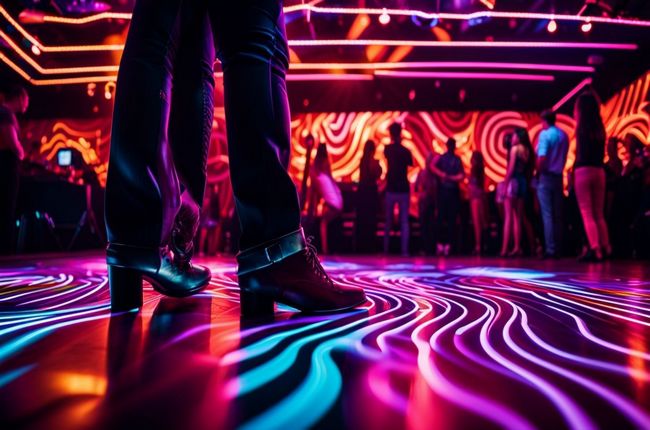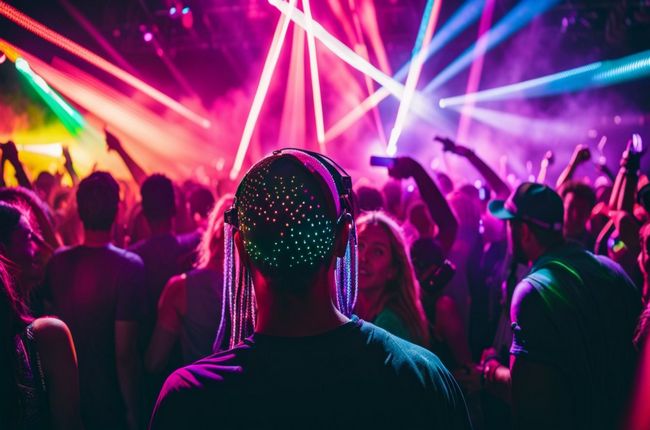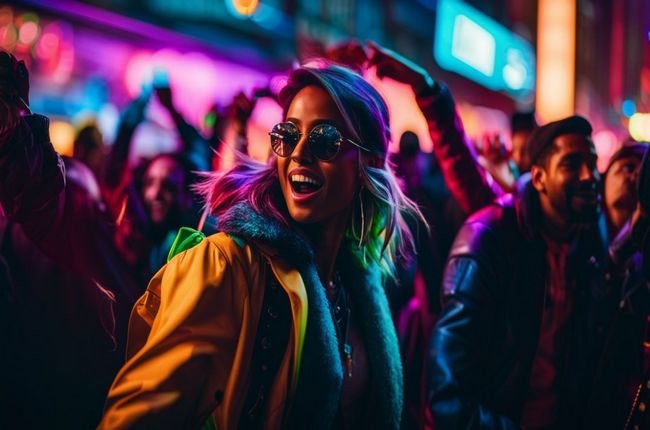Rave parties have been an attraction since always for all partiers around the world. But what exactly makes these events so popular and unique?
From EDM & Dance to the amazing light shows & weird fashions there are a lot of things that will catch your attention in the raves. In this blog post, we’ll tell you about the origins of rave culture and break down all the key elements that define a true rave party.
Wait, Are you interested in going to a rave party but worried about being safe? Don’t stress! today we’ll also cover all the tips you need to make sure your first rave experience is super fun and secure.
So without further ado, Let’s get started:
What is a Rave Party?
A rave is a gathering of people where electronic dance music and light shows come together to create an energetic, euphoric atmosphere. Raves usually take place in warehouses, clubs or other public spaces – often outdoors – and may be advertised as secretive events that require invitation or friends of invitees to attend.
Music at raves tend to be repetitive and upbeat with genres like house, techno, hardcore, dubstep and alternative typically being played by DJs across the night. The combination of music with dazzling bursts of colorful lights creates an extraordinary party experience unlike any other.
Aside from its soundscape, rave parties are also defined by its fashion – flashy outfits made up of bright colors such as neons can be seen on many revelers who want to show off their own unique style.
Origins and History of Raves
Raves have their origins in the late 1980s, first appearing as underground parties held illegally in secret locations such as warehouses and abandoned buildings. Initially associated with acid house music, rave culture became known for its groundbreaking electronica, innovative DJs, and highly energetic atmosphere.
The magical environment created by rave events led to a global spread of popularity until it reached almost every corner of the world by the end of the 1990s. While initially illegal, raves began to be organized commercially as venues started providing an alternative space for people to dance into the night with no limitation on time or performance restrictions.
As mainstream audiences become increasingly aware of electronic dance music throughout this period, raves began becoming large-scale even reaching festivals that still exist today celebrating that particular subculture all around globe.
Popularity and Appeal of Raves
Rave parties have become a mainstay of youth culture in the last few decades. Attracting thousands of partygoers from all around the world, rave events are often associated with fast-paced electronic music, electric light shows and vibrant dance scenes.
The appeal of raves lies not just in their immense musical culture but also in the values that accompany them such as peace, love, unity and respect – forming a unique community atmosphere unlike any other form of entertainment.
All this attracts people from various walks of life looking to explore new experiences and exchange ideas through dancing.
Furthermore, what makes these enjoyable is how they transcend all boundaries offering something for everyone no matter age or stature allowing them to identify with aspects or interests different than their own.
What Happens in Rave Party

Aside from dancing and music, many activities and elements make up the typical rave party experience:
Music, Dance, and Light Shows
The focal point of any rave is the music played by DJs. Styles spun include:
- House – The original core rave genre featuring 4/4 beats with samples over top. Deep house for more melodic tracks, or tech house for edgier sounds.
- Trance – Dreamy, melodic synth tracks with arpeggiated hooks and crescendoing textures to induce trance-like states. Subgenres like psytrance and hard trance provide more intensity.
- Techno – Distinctly electronic, futuristic-sounding tracks often without vocals and focused on intricately layered machine rhythms.
- Drum and Bass – Extremely fast tempo range from 170-180 BPM, heavy on aggressive basslines and fast breakbeat rhythms.
- Dubstep – Dark, grimy tracks driven by booming sub-bass frequencies and strategic tempo shifts known as “drops”.
Visual effects are also key, with lasers, projections, neon/LED lights, strobe lights, and blacklights turning the rave into a multimedia sensory explosion. Exuberant, uninhibited dancing and mixing with fellow ravers completes the social component.
Rave culture and community
Rave culture is a unique social subculture which has been growing in popularity since its inception in the 1980s. It is centered around a shared love of electronic music, dance, and art, with a mission to foster peace, love unity, respect (PLUR), and tolerance.
It emphasizes freedom of expression and acceptance of all genders, races, beliefs, identities – creating an inviting atmosphere for all who choose to join. At rave parties DJs provide soundscapes that bring people together through dancing.
Rave Fashion and Attire:
Rave fashion is an important part of the overall rave experience, inspiring attendees to express themselves in vibrant and creative ways.
Traditionally, ravers wore bright colours and clothes from different eras to make a statement and stand out from the crowd.
Eccentric, creatively DIY costumes are a huge element of rave fashion. Usually people wear the following things:
- Neon colors – Tees, tutus, crop tops, face/body paint
- Cyber goggles – LED glasses or steampunk styles
- Masks and face jewels
- Furry boots – “Party animals”
- Tight, revealing clubwear
- Costumes – Carefree play with identity
Pay attention that along with these fashions comfort is also important since ravers dance all night long. So stretchy, loose clothing that can move around easily works best. Rave fashion is all about being yourself, having fun with what you wear, and dressing for nonstop dancing.
Activities at Rave Parties:
Raves provide space for many forms of creative artistic release:
- Glowsticking – Dancing with LED glowsticks to enhance hand/arm movements
- Poi spinning – Twirling lit poi balls attached to strings rhythmically
- Orbitaling/gloving – Waving hands encased in LED gloves to dazzle
- Hooping – Spinning and manipulating lit hula hoops
- VJing – Creating rave visuals and projections in tandem to the music
- Live painters – Painting immersive images rave-side as entertainment
- Chill rooms – Spaces to relax, connect, and unwind away from intensity
These activities encourage creative flow and individuality alongside the music. They also allow “play” as a form of escape and blowing off steam through recreation.
What is Rave Party Locations
Early warehouse and field raves took place in ad hoc underground spaces. But today’s events move through more official venues:
Indoor Venues of Rave :
- Nightclubs – Established clubs transform with rave decor and DJ lineups for mass events
- Concert Halls – Large venues like sports arenas converted for multi-stage raves
- Festivals – Raves as part of larger EDM festivals with camping options
- Private Events – Mansions, lofts, and studios rented for underground rave happenings
- Abandoned Spaces – Held illegally in vacant lots, closed venues, etc. to mirror old-school raving
Outdoor Venues of Rave :
Many raves take advantage of outdoor locations, especially during summer:
- Fairgrounds – Offer large open spaces
- Deserts – Far from noise regulations for all night events
- Beaches – Picturesque seaside settings
- Campgrounds – On-site camping built in
Major EDM festivals like Burning Man, Shambhala, and Electric Forest encompass the rave ethos on a huge scale as essentially temporary outdoor cities.
While indoor clubs maintain the dark, surreal atmosphere, outdoor raves focus more on community in natural environments flooded with sunlight and fresh air, almost like spiritual pilgrimages for rave disciples.
Are Rave Parties Dangerous?
Raves walk a fine line between chaotic creativity and risky behavior. While raves offer a powerful communal experience, certain dangers need to be addressed:
Potential Dangers and Concerns
- Drug/alcohol abuse – High rates of irresponsible, binge drug use
- Unsafe venues – Risk of hazards in makeshift locations
- Medical emergencies – Overheating, exhaustion, poisoning, injuries
- Violence/assault – More common at large events
- Hearing damage – Prolonged exposure to extreme noise levels
- Law enforcement – Police shutting down illegal raves
Without proper harm reduction, raves can enable dangerous behavior. And the transience of participants makes monitoring and emergency response tougher.
Prevalence of Drug Use at Rave Parties
A survey of 600 rave attendees found:
- 60% reported taking ecstasy/MDMA
- 28% reported taking LSD
- 17% reported taking amphetamines
- 5% reported taking ketamine
So while not everyone uses substances, drug use remains widespread. Officials often target raves due to this association. Smart strategies are needed to reduce risks and make raving safer.
Are Rave Parties Legal:
The legality of rave parties can be tricky. Strictly speaking, raves are often not totally “legal” events. They sometimes happen in abandoned warehouses or other spaces without official permission. And drug use is common at raves, even though that’s illegal.
However, many raves now take place in official clubs or concert venues with proper licenses and permits. Promoters work to make them safer, more organized events.
So as long as you’re sticking to legal activities and being responsible, you likely don’t have to worry about police crashing the party. But for underground, renegade raves in sketchy spots? Those can definitely still get shut down.
The bottom line is that raving is usually fine and the authorities won’t bug you, as long as you steer clear of any illegal stuff yourself. Use good judgment and your rave experience will stay on the right side of the law.
How to Prepare for a Rave Party

Provide an adequate preparation plan to ensure a safe and enjoyable experience, by researching the venue’s policies, familiarizing yourself with rave etiquette and ensuring that you bring enough supplies for personal comfort.
Tips for staying safe and comfortable –
- Stick with friends and support each other at all times. Have designated meeting points if you become separated from your group.
- If permitted, use safety equipment like glowsticks and protective glasses during flashy light shows.
- Avoid excessive substance use such as alcohol or drugs, but practice harm reduction by limiting usage and knowing one’s limits beforehand. Never go alone if attending under the influence of any substance .
- Be mindful of surroundings and leave promptly when feeling unsafe after informing your friends first.
- Familiarize yourself with proper rave etiquette before arriving – no pushing, shoving, fighting, etc., respect regulations concerning drinking age limitations/drugs consumption strictly held in raves sites premises are taken seriously by law enforcement officers also refrain from dissing DJs or noise level performers on the night event itself-it’s simply rude!.
Hydration and Self-care –
Drink plenty of water leading up to and during the rave. Sports drinks like Gatorade also replenish electrolytes lost from heavy sweating.
Take sitting breaks when needed – don’t feel obligated to go nonstop. Cool off regularly at water stations or chillout rooms. Listen to your body’s limits and rest when exhausted.
Protect hearing by using earplugs when near loud speakers. Wear sunscreen if outdoors.
If consuming drugs, start with a low “test dose” and stay with friends you trust. Only buy from trusted sources rather than random strangers.
Conclusion
Raves are about way more than just dancing all night. They let people connect, express themselves freely, and share a love for electronic music. Sure, some risky stuff can happen at raves if you aren’t careful. But being smart and looking out for each other helps make raving feel welcoming, not dangerous.
If you go in with an open mindset and focus on staying safe, raves can be an awesome way to take a little vacation from your regular life. You’ll have an epic night of forgetting your worries, making new friends, and celebrating life to the fullest. Remember raves create memories that you’ll never forget.
Frequently Asked Questions (FAQs)
What is a rave party like?
Picture an all-night dance party with booming electronic music, trippy lights and visuals, and tons of people letting loose. Raves started in the 80s as underground dance events and still maintain that renegade vibe.
When did rave culture start?
You can trace rave roots back to the 80s acid house scene in places like Chicago and the UK. Raves hit peak popularity in the early 90s when promoters threw giant 'massives' with tens of thousands of people.
What music is played at raves?
You'll get pumping electronic dance jams like house, trance, techno, drum and bass, and dubstep. The music is high-energy to keep people moving all night long.
What do people wear at Rave Party?
Think neon, costumes, LED lights, goggles, furry boots - anything colorful and eye-catching goes! The idea is to get creative and funky with your outfit.
What drugs are associated with raves?
Substances like ecstasy (MDMA) LSD and amphetamines are frequently associated with raves. However it's important to note that one can still enjoy raving without indulging in drug use.
Is raving dangerous?
It can be if you aren't smart about it. Practicing harm reduction and looking out for each other keeps it a positive experience. Respect PLUR vibes and raves will welcome you in!

